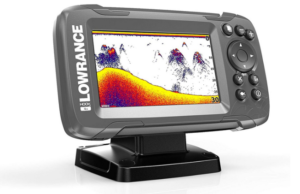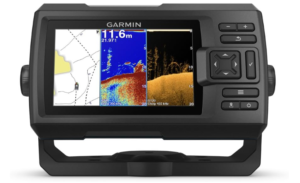Looking for the best fish finders? Read on
In the ever-evolving world of angling, the quest for the perfect catch demands the right tools, and few are as indispensable as fish finders. These devices, ranging from compact units to sophisticated systems, offer anglers unprecedented insight into the underwater world, revolutionizing the way we approach fishing.
From Garmin’s advanced sonar technology to Lowrance’s intuitive interface, and Humminbird’s high-resolution displays, the market abounds with options catering to every angler’s needs and preferences.
Whether you’re a seasoned pro seeking to refine your technique or a novice eager to explore new waters, the best fish finders serve as indispensable companions, unlocking the secrets of the depths and maximizing your chances of reeling in that trophy catch.
What Makes the Best Fish Finders?
Best Fish Finders
1) Garmin 010-01550-00 Striker 4 with Transducer
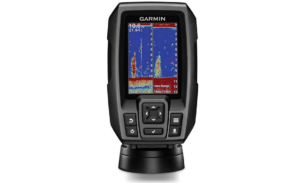
Specifications
- Display size: 3.5” diag
- Dual-frequency (50/200 kHz) sonar capable
Dual-beam (77/200 kHz) sonar capable - Transmit power 200 W (RMS)
- Maximum depth 1,600 ft freshwater, 750 ft saltwater
This Garmin 010-01550-00 Striker 4 with Transducer is the best fishfinder on the market,it features an easy-to-use 3.5-inch,high-sensitivity GPS , keypad operation ,sonar transduce and a maximum depth 1,600 ft freshwater and 750 ft saltwater.
With scanning Sonar, this gadget goes beyond the ordinary, delivering near-photographic images of what lurks beneath your boat. Say goodbye to guesswork, as detailed representations of objects, structures, and fish are brought to life right before your eyes.
2) Humminbird HELIX 5 Fish Finder
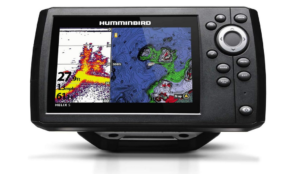
Specifications
- Size:5″ Diagonal
- GPS Receiver
- Humminbird Basemap Built-In
- Humminbird AutoChart Live
This Humminbird HELIX 5 Fish Finder is designed to take your fishing game to the next level. Let’s dive into why this device is a must-have for any angler serious about maximizing their catch.
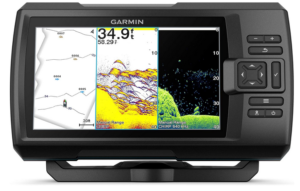
Specifications
- Screen Size: 7 Inches
- GT20 transducer
- ClearVü scanning sonar
- Wi-Fi connectivity
The Garmin Striker Vivid 7cv Fishfinder and Sonar Transducer is one of the best fishfinders, it features a GT20 transducer for built-in Garmin CHIRP traditional sonar, built-in Quickdraw Contours mapping, Wi-Fi connectivity, and an easy to use Easy-to-use 7” screen.
With its easy-to-use 7-inch color display and new vivid scanning sonar color palettes, the Striker Vivid 7cv offers unrivaled visibility. Say goodbye to squinting at blurry images—this device makes it effortless to distinguish fish and underwater structures, giving you the edge you need to reel in the big ones. Plus, the included tilt/swivel bailmount bracket ensures convenient positioning for optimal viewing angles.
With the GT20 transducer, you’ll have access to built-in Garmin CHIRP traditional sonar and CHIRP ClearVü scanning sonar. Whether you’re targeting fish in shallow waters or probing deeper depths, this transducer delivers unparalleled clarity and detail, ensuring you never miss a thing beneath the surface.
Thanks to the high-sensitivity GPS, you can effortlessly mark waypoints, create routes, and monitor your boat’s speed with pinpoint accuracy.
With built-in Quickdraw Contours mapping, you can create custom maps of your favorite fishing spots in real time, giving you the freedom to explore uncharted waters with confidence.
But that’s not all. With Wi-Fi connectivity, you can take your fishing experience to the next level. Connect to the ActiveCaptain app with your compatible smartphone to transfer waypoints, receive smart notifications (including software update notifications), and access the Garmin Quickdraw Community. Stay connected, stay informed, and stay ahead of the game with the Garmin Striker Vivid 7cv.
Specifications
- Screen size: 4 inches
- Wide-angle sonar cone
- Quick access keypad
Read Also: 5 Best Bilge Pumps
Guide to Choosing the Best Fish Finders
A fish finder is an instrument that is specifically designed to detect fish underwater. A fish finder detects fish by detecting reflecting impulses of sound energy. Later, the electronic impulses that are reflected from the fish are converted to information that is displayed in graphic form on the fish finders screen.
Fishfinders can be used to measure the depth of the water, to know the bottom structure, and to locate the underwater debris. The image shown on the screen is in the form of a small icon or a series of arches.
Here are some of the factors to consider when choosing the best fish finders in the market:
Display; resolution, and color
When considering the display, the most important thing is the pixels. The more the pixels, the more detailed your view will be. However, more pixels mean a higher price for the fish finder.
The minimum pixels for the screen that I would suggest would be 240(v) x 160(h). The images will not be as clear, but you will find fish with that. For clearer images, you will need to invest more money in your fishfinder. The best fish finders have a clear and crystal display.
The displays will come in different sizes. Just like in pixels, the larger the display, the clearer your images will be displayed. With a larger display, it is also easier to differentiate all the data displayed such as numbers and echoes.
You can also get a colored or a black and white screen if your budget is low. However, a colored screen has the advantage of showing you images in over a million colors. The colored screen also has an easier viewing screen as it has the brighter light of what is going on under the water.
Transducer
It is one of the most important factors or features to look for when shopping for fish finders. Its function is to send sound waves to show what is underneath the water surface.
A sonar signal that the transducer sends to the water bounces off the objects that are underneath and then they are picked up by the transducer. This signal is what is translated into a picture.
A transducer’s most important feature is the cone angle. To get a bigger perspective of what is underneath, choose a bigger degree on the cone. The wider the beam, the more the area it covers hence allowing for more fish within the angle.
This, however, has the disadvantage of losing strength and hence cannot penetrate the water as deep and narrow as the cone. A narrow beam goes deeper even in shallow water and can also give information on the composition of the bottom.
To get the most of both beams, there is the dual-beam type of transducers. It combines both the wider cone and narrow cone in one unit. They include multiple beams which can be 4 or more.
These cover a very larger area of the underwater and can even give a 3D image on the display. One more option is the latest which is the side beam transducer. These units shoot their signals to the sides, which increases the search area for fish.
Portability
Fishfinders can come as portable or as fixed units. The best fish finders should be portable to move with to different locations, they should also be easy to install.
A fish finder has to be portable to suit your needs. This feature is the best option for people who lease their boats. Portability is also important if you ice fish or fly in. Fishfinders that are portable come with a carrying case and a power supply.
Most fish locators come with a transom mount for installation. They also come with an attached transducer on the transom with the use of a suction cup.
For fishers who are more settled and for craft owners, the best choice would be a fixed unit. This type can be mounted to any location on the boat. According to what you prefer, you can mount your unit on the hull, trolling engine, or the stern.
Power supply
Like any other electronic type of equipment, fish finders need electricity to function. The electricity on the boats is usually supplied by batteries installed in a battery compartment.
Most fish finders use the DC12-24 volt to power their boats. As long as the voltage is of that range, your fish finder will function properly. The product specification manual that is attached to the fish finder will give you more information on which battery system is best for you.
Smaller boats use one 12 DC volt battery while larger boats use two 12 DC volt batteries. When choosing the best fish finders look at the power supply and capacity, it is very crucial for a nice fishing experience.
Both the battery and the power cable are connected to the same switchboard. To turn off the fish finder unit quickly, install the manual switches on the power cable.
To avoid malfunctions on the fish finder, always remember to turn it off before cutting the power off. If your boat uses 24 volts of battery, the fish finder must be attached to the switchboard.
Also, the capacity of the boat is predetermined. The capacity means how much charge the battery can deliver at a given voltage. Larger batteries offer a longer operational time while smaller batteries keep the fish finder active for a short time.
When connecting the fish finder to the boat power, it is important to separate the batteries that power up the engine and those of the fish finder. This is to prevent the engine noise from interfering with the signal that goes to the fish finder. Therefore, it is important to install the power cable and the transducer cable far apart as possible.
The strength of the echo
A fish finder also makes it possible to identify the different sediments in the seabed. A red or brown line is shown on the screen of the fish finder when the seabed generates a strong echo after being hit by ultrasonic waves.
You will also see that the amount of seabed displayed by the fish finder will change depending on the hardness and the composition of the bed.
When the echo coming from the seabed is strong, a larger amount is displayed on the fish finder. This means the bottom of the sea is hard as it consists of bedrock or reefs.
The opposite is also true. A weak signal means that the bottom is soft hence returning a thin echo. In this case, the seabed consists of Sandy soil.
The frequency used by the fish finder will also determine the amount of seabed displayed. When low-frequency ultrasonic waves are used the bottom band increases and when high-frequency ultrasonic waves are used, the displayed bottom band decreases.
A fish finder with a frequency of 50kHz is the best as you will be able to judge the properties of the seabed.
Fishfinder with GPS in one unit
The best fish finders in the market must have GPS. A GPS helps calculate the exact position you are in. Having GPS and fishfinder as a single unit is not only economical but also saves on space and makes it convenient.
A GPS unit gives you the advantage of being able to mark fish-prone areas and easily return to them in the future. This is because a GPS unit makes it possible to mark areas you have been to before. Most efficient units can mark thousands of such spots.
A GPS unit also makes it possible for you to navigate through the waters. To get this feature, get a unit that has background maps and charts. A GPS unit also offers safety. This is because it tracks every place you go including where you started at.
Therefore, you can trace where you came from no matter how far into the sea you will go fishing. The GPS unit will also tell you how far from home you are.
The frequency
When getting a fish finder, be sure the unit has the right frequency. The frequency of the transducer is directly related to the angle of the cone. A high frequency of the transducer gives more detail on the screen, and a low frequency gives less detail. The market offers models that have dual, multiple, and single frequencies.
How Fish Finders Work
In our quest to discover the best fish finders, it is crucial to understand how these fish finders work.
A fish finder is helpful in detecting a fish-prone area. It also provides different underwater information like the distribution of the fish school, water depth, and the condition of the seabed.
This is done by transmitting the ultrasonic waves into the sea and receiving their reflection. Some of the sonic waves that have been transmitted reflect back to the source when they come across an object. The most important feature of a fish finder is the ultrasonic feature.
The fish finder transmits ultrasonic waves directly underneath the boat. If the fish finder comes close to a fish school, weaker reflections will go back to where the ultrasonic waves had been transmitted originally.
The received reflection is later converted to an electrical signal and then sent to the receiving circuit of the fish finder
Signals are amplified by the receiving unit and a processor unit processes them to get images on the screen. For colored screens, stronger reflections are shown in the colors orange and red while weaker colors are shown in blue and green.
The larger the fish school, the more the signals on the screen hence showing a reddish color, a small fish school will be shown in color blue. In short, the color on the screen shows the condition of the seabed.
A fish finder has a main unit that comes with the screen and the transducer. The screen is located in a place where it is easily accessed in the cabin. The transducer, on the other hand, should be mounted on the bottom of the boat, either through in-hull installation or hull installation.
The performance of the fish finders transducer is based on whether the transducer is mounted properly at the bottom of the boat. If the transducer is not mounted properly, chances of failure are very high as the transducer captures waves resulting in serious defects.
To avoid such cases, it is advisable to have an expert install the transducer for you.
Types of Fish Finders and Depth Finders
Getting the best fish finders in the market is quite a process and a broad specter of knowledge. Let’s look at the types of Fish Finders.
There are three fish finder choices available namely:
- Standalone fishfinders t
- Combination
- Fully networked system
A networked system
This type of fish finder will support a huge range of data sources including radar, raster, and vector GPS charts, video, and Sirius XM satellite radio. Many allow Bluetooth or Wi-Fi, and you can control them from your iPhone or Android smartphone.
A multiple display network system is good for medium or large-sized boats. Some of the best fish finders in the market fall in this category.
Combination fishfinder/chart plotter
Combination units make sense for most owners of mid-sized boats. They use GPS for navigation to the fishing grounds, view both on a split-screen, or view only the fish finder. “Black box” sounder modules can turn many chart plotters into combination units, with the installation of a transducer.
Standalone fish finders
If all you want is to see what is below in the sea, this type of fish finder will be the best for you. They give the biggest display and offer better performance at a low cost.
Also, if you are on a tight budget, a standalone fishfinder will suit your needs. If your boat has space for larger displays, consider getting a bigger screen. A GPS unit can be added to many units in the future making them chart plotter combinations.
Fish Finders Advantages
Guessing the size of fish: Catching fish can be very exciting, but realizing the fish you have caught is small can lead to frustrations. A fish finder, however, makes it easier for fishermen. It helps in guessing the size of the fish in the area you are in. This device will get you to the fish you had targeted all day.
Understanding the speed of waves: the GPS feature on the fish finder is very helpful in understanding the wave speed in the water. Knowing the speed of the wave makes you avoid any hassle when fishing. The GPS also gives alerts on how far the wave is from your vessel.
Assuming the number of fish in the seabed: A fish finder enables you to guess the number of fish in the area you are at before you start fishing. This is very helpful as it prevents the fisherman from wasting time in an area with little fish. The screen will also show you the number of fish underneath your boat.
Affordable in price: Most fishermen assume that fish finders are insanely expensive. This is however not true. You can purchase a fish finder according to your budget. Moreover, your fish finder will also have more features and a GPS at an affordable price.
Determining depth: Before placing bait in the water, it is advisable to know how deep the waters are. A fish finder will be the perfect tool for you as it tells the depth of the waters below you. This will be helpful when fishing in areas you have never been to.
Determine the location of fish: Just think, how surprising it is that you see the location of fish underwater on a big screen. By installing a fish finder in your boat you can determine the presence of fish underwater. Without the tool, it is really tough to determine the location of the school of fish underwater.
Water temperature: A GPS can help determine the temperature of the waters below you. A horizontal line on the screen will help find out how cool or hot the water zone is. Some species of fish find comfort in hot areas while others find comfort in cool waters. Therefore, the temperature will help you get the fish you are looking for.
Conclusion
My final verdict is that getting one of the best fish finders is an incredible investment.
Every modern fisherman should get one to make it easier and faster to find fish. A good model can be expensive but will have more benefits. Also, an expensive model is of good quality and will last longer.
Fishfinders make fishing more fun, and since enjoyment is what fishing is about, you simply can’t put a price on enjoyment. Get a fish finder at your budget and spot the fish easier.
Read Also : 6 Best Binoculars for Boating/Fishing

